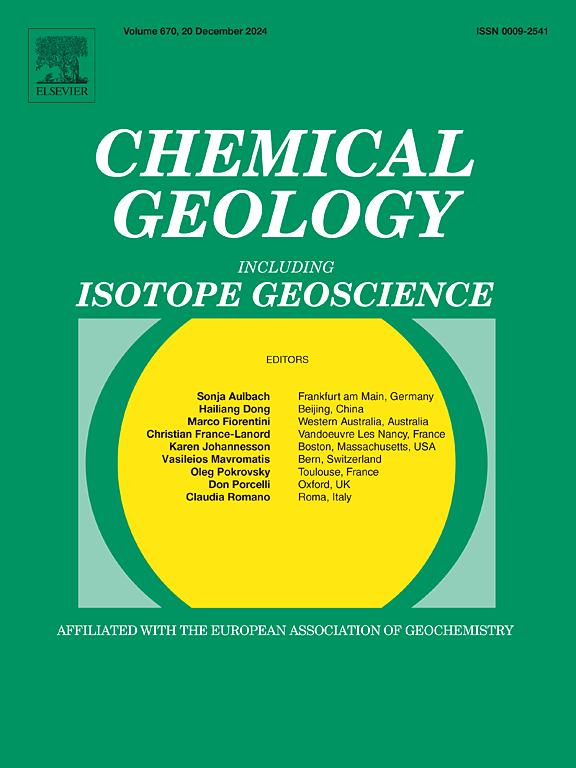Magmatic tempo within the Paleoproterozoic ophiolitic mélange, Northern Kongling Complex, Yangtze Craton: Dynamics of a Paleoproterozoic subduction zone
IF 3.6
2区 地球科学
Q1 GEOCHEMISTRY & GEOPHYSICS
引用次数: 0
Abstract
Paleoproterozoic ophiolitic mélanges, which are rare worldwide, provide significant insights into the structures of ancient orogens and the onset of modern plate tectonics. Here, we report a spatially and temporally linked arc magmatic association comprising circa 2.1–2.0 Ga EMORB-affinity gabbros and diabases, arc-affinity basalts, hornblendites, high-Mg andesites, and granites from the Paleoproterozoic Shuiyuesi ophiolitic mélange in the Northern Kongling Complex, Yangtze Craton. Structural analyses reveal that the mélange is characterized by a series of imbricated NEE-trending reverse faults and late-stage NNW-trending normal faults. Zircon U![]() Pb dating indicates that mafic rocks within the mélange belt primarily formed at ca. 2.1 Ga and metamorphosed at ca. 2.0 Ga, while granites mainly formed at ca. 2.0 Ga. The gabbros and diabases are characterized by enriched LREE patterns without negative Nb and Zr anomalies, displaying an EMORB-like geochemical affinity. In contrast, the arc-affinity basalts exhibit slightly enriched LREE patterns with negative Nb and Zr anomalies. The hornblendites and high-Mg andesites have higher MgO, Ni and Cr contents and display more fractionated REE patterns and larger negative Nb and Zr anomalies compared to the arc-affinity basalts. We propose that tholeiitic EMORB-affinity gabbros and diabases, arc-affinity basalts and calc-alkaline high‑magnesium andesites record a geological transition from subduction initiation to mature island arc magmatism. Granites are characterized by highly fractionated REE patterns, negative zircon εHf(t) values (−6.3 to −19.3) with Archean Hf isotope TDM1 ages. We suggest that they formed through the partial melting of thickened Archean crusts during a syn-collision stage. Together with the existing studies, the Shuiyuesi mélange preserves an intact record of subduction-related and syn-collision magmatism and high-pressure metamorphism, indicating that modern-style plate tectonics characterized by cold and deep subduction has been operated since at least 2.1–2.0 Ga during Paleoproterozoic.
Pb dating indicates that mafic rocks within the mélange belt primarily formed at ca. 2.1 Ga and metamorphosed at ca. 2.0 Ga, while granites mainly formed at ca. 2.0 Ga. The gabbros and diabases are characterized by enriched LREE patterns without negative Nb and Zr anomalies, displaying an EMORB-like geochemical affinity. In contrast, the arc-affinity basalts exhibit slightly enriched LREE patterns with negative Nb and Zr anomalies. The hornblendites and high-Mg andesites have higher MgO, Ni and Cr contents and display more fractionated REE patterns and larger negative Nb and Zr anomalies compared to the arc-affinity basalts. We propose that tholeiitic EMORB-affinity gabbros and diabases, arc-affinity basalts and calc-alkaline high‑magnesium andesites record a geological transition from subduction initiation to mature island arc magmatism. Granites are characterized by highly fractionated REE patterns, negative zircon εHf(t) values (−6.3 to −19.3) with Archean Hf isotope TDM1 ages. We suggest that they formed through the partial melting of thickened Archean crusts during a syn-collision stage. Together with the existing studies, the Shuiyuesi mélange preserves an intact record of subduction-related and syn-collision magmatism and high-pressure metamorphism, indicating that modern-style plate tectonics characterized by cold and deep subduction has been operated since at least 2.1–2.0 Ga during Paleoproterozoic.
求助全文
约1分钟内获得全文
求助全文
来源期刊

Chemical Geology
地学-地球化学与地球物理
CiteScore
7.20
自引率
10.30%
发文量
374
审稿时长
3.6 months
期刊介绍:
Chemical Geology is an international journal that publishes original research papers on isotopic and elemental geochemistry, geochronology and cosmochemistry.
The Journal focuses on chemical processes in igneous, metamorphic, and sedimentary petrology, low- and high-temperature aqueous solutions, biogeochemistry, the environment and cosmochemistry.
Papers that are field, experimentally, or computationally based are appropriate if they are of broad international interest. The Journal generally does not publish papers that are primarily of regional or local interest, or which are primarily focused on remediation and applied geochemistry.
The Journal also welcomes innovative papers dealing with significant analytical advances that are of wide interest in the community and extend significantly beyond the scope of what would be included in the methods section of a standard research paper.
 求助内容:
求助内容: 应助结果提醒方式:
应助结果提醒方式:


